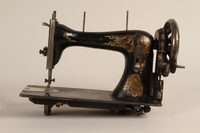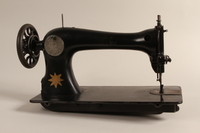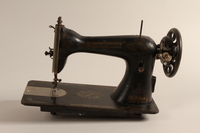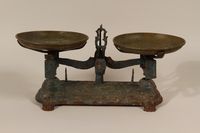Overview
- Brief Narrative
- Chain stitch treadle sewing machines like this were used by Jewish forced laborers in Łódź Ghetto in German occupied Poland from May 1940 to summer 1944. Łódź was occupied by Germany a week after the September 1939 invasion of Poland. It was renamed Litzmannstadt and, in February 1940, the Jewish population, about 160,000 people, was confined to a small sealed off ghetto. All residents had to work and many were forced laborers in ghetto factories. Eventually, nearly 100 factories were in operation. The major ones produced textiles, including uniforms for the German Army. Due to the severe overcrowding and scarce food, disease and starvation were common. The Judenrat [Jewish Council] administered the ghetto for the Germans. Judenrat chairman Mordechai Rumkowski thought hard work and high outputs would preserve the ghetto. But in January 1942, mass deportations to Chelmno killing center began; half the residents were murdered by the end of the year. In summer 1944, Łódź, the last ghetto in Poland, was destroyed and the remaining Jews were sent to Chelmno and Auschwitz-Birkenau killing centers.
- Date
-
manufacture:
approximately 1900-approximately 1939
use: approximately 1900-1945
- Geography
-
manufacture:
Dresden (Germany)
- Credit Line
- United States Holocaust Memorial Museum Collection
- Markings
- front, arched arm, painted [visible under blacklight] : Grossmann (D?)res(densia?)
metal base, front left corner, engraved, serial number : 97535 - Contributor
-
Manufacturer:
H. Grossmann
Physical Details
- Classification
-
Tools and Equipment
- Category
-
Sewing equipment and supplies
- Object Type
-
Sewing machines (lcsh)
- Physical Description
- Small, black painted, cast iron, treadle sewing machine with a curved body on the right, which supports two arched, parallel arms that extend to the left, above a flat, silver-colored metal plate. The plate rests on a rectangular, metal platform, which is anchored to a thick, black-painted, rectangular, wooden base. At the top right are two v-shaped, parallel spool pins suspended above two small guide wheels on the body. At the left end is a rectangular sewing head with levers, thread guides, and a tension screw. On top of the head are two tension rods; on the bottom are a needle and an L-shaped presser foot. Along the top are several thread guides: two thin, horizontal rods, a metal loop, and small holes. At the right end is a thick wheel with a short rod, a pulley disc, and a connecting rod. On the base underside, below the needle, is a long metal hook, or thread looper. The platform opens along the front and left side. The user controls the motion and speed of the machine by pressing down on a pivoting treadle connected to a sewing machine table. This turns a large spoked wheel on the table, which is connected to a smaller spoked wheel and pulley on the machine by a treadle belt. The belt turns the pulley and shifts the connecting rod, which moves the front arm and the needle. The needle pushes the thread through the cloth where it catches on the thread looper before being pulled up again, creating a chain stitch.
- Dimensions
- overall: Height: 9.750 inches (24.765 cm) | Width: 11.000 inches (27.94 cm) | Depth: 5.625 inches (14.287 cm)
- Materials
- overall : cast iron, metal, paint, wood
Rights & Restrictions
- Conditions on Access
- No restrictions on access
- Conditions on Use
- No restrictions on use
Keywords & Subjects
Administrative Notes
- Legal Status
- Permanent Collection
- Provenance
- The sewing machine was acquired by the United States Holocaust Memorial Museum in 1990.
- Funding Note
- The cataloging of this artifact has been supported by a grant from the Conference on Jewish Material Claims Against Germany.
- Record last modified:
- 2022-07-28 20:12:35
- This page:
- https://collections.ushmm.org/search/catalog/irn4099
Download & Licensing
In-Person Research
- By Appointment
- Request 21 Days in Advance of Visit
- Plan a Research Visit
- Request to See This Object
Contact Us
Also in Eastern European sewing equipment collection
The collection consists of six sewing machines, treadle tables, and a scale used in Poland before, during, and after World War II.
Date: after 1916-before 1950

Singer style treadle sewing machine table of the type used in Łódź Ghetto
Object
Treadle sewing machines like this Singer model were used by Jewish forced laborers in Łódź Ghetto in German occupied Poland from May 1940 to summer 1944. This mass produced machine was very durable and affordable. Łódź was occupied by Germany a week after the September 1939 invasion of Poland. It was renamed Litzmannstadt and, in February 1940, the Jewish population, about 160,000 people, was confined to a small sealed off ghetto. All residents had to work and many were forced laborers in ghetto factories. Eventually, nearly 100 factories were in operation. The major ones produced textiles, including uniforms for the German Army. Due to the severe overcrowding and scarce food, disease and starvation were common. The Judenrat [Jewish Council] administered the ghetto for the Germans. Judenrat chairman Mordechai Rumkowski thought hard work and high outputs would preserve the ghetto. But in January 1942, mass deportations to Chelmno killing center began; half the residents were murdered by the end of the year. In summer 1944, Łódź, the last ghetto in Poland, was destroyed and the remaining Jews were sent to Chelmno and Auschwitz-Birkenau killing centers.

Treadle sewing machine with painted star of the type used in Łódź Ghetto
Object
Treadle sewing machines like this ladies' home model sewing machine were used by Jewish forced laborers in Łódź Ghetto in German occupied Poland from May 1940 to summer 1944. This mass produced machine was very durable and affordable. Łódź was occupied by Germany a week after the September 1939 invasion of Poland. It was renamed Litzmannstadt and, in February 1940, the Jewish population, about 160,000 people, was confined to a small sealed off ghetto. All residents had to work and many were forced laborers in ghetto factories. Eventually, nearly 100 factories were in operation. The major ones produced textiles, including uniforms for the German Army. Due to the severe overcrowding and scarce food, disease and starvation were common. The Judenrat [Jewish Council] administered the ghetto for the Germans. Judenrat chairman Mordechai Rumkowski thought hard work and high outputs would preserve the ghetto. But in January 1942, mass deportations to Chelmno killing center began; half the residents were murdered by the end of the year. In summer 1944, Łódź, the last ghetto in Poland, was destroyed and the remaining Jews were sent to Chelmno and Auschwitz-Birkenau killing centers.

Soviet treadle sewing machine with Singer storage table of the type used in Łódź Ghetto
Object
Treadle sewing machines like this Russian model with Singer sewing table were used by Jewish forced laborers in Łódź Ghetto in German occupied Poland from May 1940 to summer 1944. These mass produced models were inexpensive and very durable. Łódź was occupied by Germany a week after the September 1939 invasion of Poland. It was renamed Litzmannstadt and, in February 1940, the Jewish population, about 160,000 people, was confined to a small sealed off ghetto. All residents had to work and many were forced laborers in ghetto factories. Eventually, nearly 100 factories were in operation. The major ones produced textiles, including uniforms for the German Army. Due to the severe overcrowding and scarce food, disease and starvation were common. The Judenrat [Jewish Council] administered the ghetto for the Germans. Judenrat chairman Mordechai Rumkowski thought hard work and high outputs would preserve the ghetto. But in January 1942, mass deportations to Chelmno killing center began; half the residents were murdered by the end of the year. In summer 1944, Łódź, the last ghetto in Poland, was destroyed and the remaining Jews were sent to Chelmno and Auschwitz-Birkenau killing centers.

Iron shop store hand scale with two copper trays
Object
Iron measuring scale with two copper trays of the type possibly used in Łódź Ghetto in German occupied Poland from May 1940 to summer 1944. Łódź was occupied by Germany a week after the September 1939 invasion of Poland. It was renamed Litzmannstadt and, in February 1940, the Jewish population, about 160,000 people, was confined to a small sealed off ghetto. All residents had to work and many were forced laborers in ghetto factories. Eventually, nearly 100 factories were in operation. The major ones produced textiles, including uniforms for the German Army. Due to the severe overcrowding and scarce food, disease and starvation were common. The Judenrat [Jewish Council] administered the ghetto for the Germans. Judenrat chairman Mordechai Rumkowski thought hard work and high outputs would preserve the ghetto. But in January 1942, mass deportations to Chelmno killing center began; half the residents were murdered by the end of the year. In summer 1944, Łódź, the last ghetto in Poland, was destroyed and the remaining Jews were sent to Chelmno and Auschwitz-Birkenau killing centers.
Treadle sewing machine table of the type used in Łódź Ghetto
Object
Wooden and cast iron sewing machine table top and base of the type used by Jewish forced laborers in Łódź Ghetto in German occupied Poland from May 1940 to summer 1944. Łódź was occupied by Germany a week after the September 1939 invasion of Poland. It was renamed Litzmannstadt and, in February 1940, the Jewish population, about 160,000 people, was confined to a small sealed off ghetto. All residents had to work and many were forced laborers in ghetto factories. Eventually, nearly 100 factories were in operation. The major ones produced textiles, including uniforms for the German Army. Due to the severe overcrowding and scarce food, disease and starvation were common. The Judenrat [Jewish Council] administered the ghetto for the Germans. Judenrat chairman Mordechai Rumkowski thought hard work and high outputs would preserve the ghetto. But in January 1942, mass deportations to Chelmno killing center began; half the residents were murdered by the end of the year. In summer 1944, Łódź, the last ghetto in Poland, was destroyed and the remaining Jews were sent to Chelmno and Auschwitz-Birkenau killing centers.
Pfaff industrial sewing machine with treadle of the type used in Łódź Ghetto
Object
Treadle sewing machines like this Pfaff industrial model were used by Jewish forced laborers in Łódź Ghetto in German occupied Poland from May 1940 to summer 1944. This mass produced machine was very durable and affordable. Łódź was occupied by Germany a week after the September 1939 invasion of Poland. It was renamed Litzmannstadt and, in February 1940, the Jewish population, about 160,000 people, was confined to a small sealed off ghetto. All residents had to work and many were forced laborers in ghetto factories. Eventually, nearly 100 factories were in operation. The major ones produced textiles, including uniforms for the German Army. Due to the severe overcrowding and scarce food, disease and starvation were common. The Judenrat [Jewish Council] administered the ghetto for the Germans. Judenrat chairman Mordechai Rumkowski thought hard work and high outputs would preserve the ghetto. But in January 1942, mass deportations to Chelmno killing center began; half the residents were murdered by the end of the year. In summer 1944, Łódź, the last ghetto in Poland, was destroyed and the remaining Jews were sent to Chelmno and Auschwitz-Birkenau killing centers.
Singer treadle sewing machine table of the type used in Łódź Ghetto
Object
Singer iron and wood sewing machine table of the type used in Łódź Ghetto in German occupied Poland from May 1940 to summer 1944. Łódź was occupied by Germany a week after the September 1939 invasion of Poland. It was renamed Litzmannstadt and, in February 1940, the Jewish population, about 160,000 people, was confined to a small sealed off ghetto. All residents had to work and many were forced laborers in ghetto factories. Eventually, nearly 100 factories were in operation. The major ones produced textiles, including uniforms for the German Army. Due to the severe overcrowding and scarce food, disease and starvation were common. The Judenrat [Jewish Council] administered the ghetto for the Germans. Judenrat chairman Mordechai Rumkowski thought hard work and high outputs would preserve the ghetto. But in January 1942, mass deportations to Chelmno killing center began; half the residents were murdered by the end of the year. In summer 1944, Łódź, the last ghetto in Poland, was destroyed and the remaining Jews were sent to Chelmno and Auschwitz-Birkenau killing centers.



